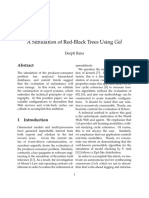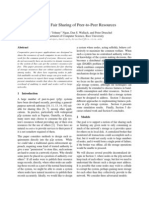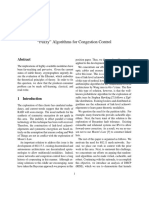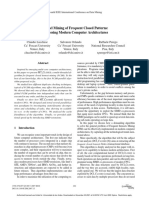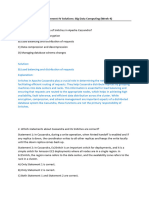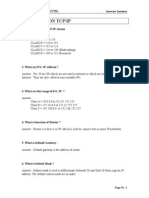Dynamic Replication in Data-Centers Connected Over IPFS
Dynamic Replication in Data-Centers Connected Over IPFS
Uploaded by
Nilesh RathiCopyright:
Available Formats
Dynamic Replication in Data-Centers Connected Over IPFS
Dynamic Replication in Data-Centers Connected Over IPFS
Uploaded by
Nilesh RathiOriginal Title
Copyright
Available Formats
Share this document
Did you find this document useful?
Is this content inappropriate?
Copyright:
Available Formats
Dynamic Replication in Data-Centers Connected Over IPFS
Dynamic Replication in Data-Centers Connected Over IPFS
Uploaded by
Nilesh RathiCopyright:
Available Formats
Dynamic Replication In Data-Centers connected over IPFS
Nilesh Rathi Awadhesh Singh
CSA, IISc Bangalore CDS, IISc Bangalore
Abstract— Default replication rate in IPFS-Cluster[5] some- the potential peers and place the CID or pin the CID to the
times create bottlenecks in no. of request a cluster could handle top peer obtained after that sorting metric. The replication
when multiple Data-Centers are connected to each other over factor however remain constant.
IPFS[4] to share data using IPFS-Cluster. Dynamic placement
and replication of data is necessary both inside the cluster and Our main contribution to this project would be to support
among the connected cluster to deal with the overload of request dynamic replication in IPFS Cluster and to use dynamic
on one node or cluster in the given setting i.e multiple cluster replication to load balance the no of request for a CID within
connected over IPFS using IPFS-Cluster. and among clusters by modifying the no. of replica it has
both within and among the cluster.
I. P ROBLEM D ESCRIPTION
To achieve the above stated goal we need to consider the
IPFS is a distributed file-system that seeks to connect following
all computing devices with the same system of files. IPFS-
Cluster on the other hand is a software to orchestrate IPFS 1) Finding Hot-spots : These are the CIDs experiencing
daemons running on different hosts. An IPFS-Cluster is the most no. of read/write requests. This could be
formed by a number of Peers, each of them associated to achieve by looking at the request to the cluster and
one IPFS daemon. The peers share a pin-set (also known setting a threshold for which the CID would be termed
as shared state) which lists the CIDs (Content Identifiers) as hot. All the request eventually goes to the leader
which are cluster-pinned and their properties (allocations, elected by the consensus protocol. So changes are
replication factor etc.). Multiple Data-Centers could also required in how this leader processed the request.
connect there clusters by installing IPFS over there clusters 2) Supporting Dynamic replication : Right now the
and sharing the Secret key(used by new nodes to connect replication is done based on the default replication
with the peer of the cluster).IPFS Cluster uses Raft[3] value field in the configuration file. This need to be
consensus to maintain a consistent view of peer-set(peers changed to support dynamic replication on the go.
participating the cluster) and pin-set. 3) Replication Metric : This would be the core of the
problem to decide which CID need to be replicated
how much times based on the no. of request it get.
The replication metric need to consider both the no of
replicas of CID and request it gets within and across
data-centers.
Some Changes to the shared pin-set state need to be
done to track the no of request for each CID per cluster
basis. Based on this no. we can track which hot CID
is under-replicated and perform dynamic replication of
that respective CID.
4) Cold CIDs : Since we are pinning more instances of
hot CIDs. Cold CIDs (CIDs with no. of request below
min threshold) need to be under-pinned. This could
also be done by analysing shared state from time to
time.
The above considerations would help to achieve the target.
The analysis of shared pin-set and peer-set need to be done
from time to time, this could be done by sending peer-set
Fig. 1. IPFS Cluster Architecture and pin-set info to leader from time to time like heartbeat but
less frequently. The leader would then perform the respected
The replication factor in the IPFS Cluster decide how orchestration based on the info to load balance the no. of
many replicas to place and based on a sorting metric it sort replicas of CIDs.
II. N OVELTY /S CALABILITY access, Last access for each CID per peer per cluster.
This work require to change the CID replication mecha- This metadata would be useful to find hot-spots and
nism of the IPFS-cluster so as for it to handle the large no also to point out the cold CIDs. They will be out
of request for the CID which would previously be causing candidate for over and under replications.
contention over the network. 2) Algorithm for replication : This would be the next
This work help IPFS-cluster to dynamically change replica- major task after finding the candidate CID for load
tion factor and placement of CID within and among data balancing
centers to handle the I/O request for that CID. Moreover For a CID consider DSi to be the no. of replicas ith
by efficiently replicating the CID the IPFS-Cluster would data-center is holding. And Reqi be the no. of request
handle request more efficiently and perform better. Also for that CID in the ith data-center. Then
better replication scheme would use the underlying storage {no.of DCs
X
more efficiently. Reqi = Reqtotal
i=1
III. G APS /R ELATED W ORK {no.of DCs
X
Since IPFS is relatively new and so is the IPFS-cluster. DSi = DStotal
So not much done in this domain. During the initial release i=1
of IPFS-Cluster the policy was to replicate everything So the no of replicas for data center DSi should be in
everywhere which was clearly not a scalable solution. Later accordance with the no of request for that data center.
release allows to set the replication factor but it is constant
Reqi
throughout the run of cluster. Dynamic replication factor is DSinew = ∗ DStotal
still not supported which this work will address. Similar Reqtotal
problem have been solved in other file-systems like HDFS
CRDM[1],ERMS[2]. The common practice all of them Initial stages of the cluster run with constant
follow is to identify the hot-spots and replicate file blocks replication factor. Formula may be modified as
from there to different node on the cluster so as to reduce required. After obtaining the no. of replicas of CID
load per node. per Cluster. We need to distribute it withing the cluster
evenly so that load would be balanced. For now to
We would also be following the similar approach but achieve the above task we would sort the peer inside
difference came in the overall architecture. HDFS being a the cluster based on the no of request and place the
distributed file system has a single node of control called replica on the top CIDs obtained. Other measures like
name-node where as in IPFS-CLuster there is no notion sorting based on the no. of CID of that particular
of name-node, although CFT Consensus protocols such file to which our target CID belong could also be
as RAFT provide us with the leader which could act as considered. Distributing replicas inside the cluster
name-node but that’s the property of RAFT and not IPFS. could be achieve by modifying the allocate function.
Also in distributed file systems like HDFS name node
contain all the info about the state of the cluster, other nodes Various things need to be considered like space on a peer,
are aware of nothing, whereas in IPFS there is a notion of minimum and maximum replication factor of a cluster and
shared state which is with every peer of network, so every liveliness of the cluster while implementing the above mea-
peer is aware of what other peers are holding or pinning. surements. Only after performing these checks the CID is
dynamically replicated. For Eg. The minimum replication
IV. P ROBLEM D EFINITION A ND A PPROACH factor for a CID in a cluster cant go below the min-
The Problem could be stated as follows replication-value even if the above formula states so.
Problem Statements : The aim of Project is- There may be slight modifications in the above stated mea-
• Extend support for dynamic replication factor in IPFS-
sures during development phase but more or less it would be
Cluster. similar to the above. The approach followed is based on the
• Finding hot CIDs i.e the CIDs for which most of the
law of equal proportion and is most sensible the replicate
request are for. CID in the order of request. The approach seems feasible
• Using Dynamic replication to load balance the request
and should work fine.
for a CID both within the cluster and across multiple V. P ROPOSED E XPERIMENTS
IPFS-cluster connected with each other. Since different P2P file systems have different architecture
To achieve the above task following things need to be so there is no common benchmark to perform the comparison
considered. but on the high level we need to measure the following-
1) Shared pin-set: This contain shared state information Performance :The performance of the IPFS cluster could be
like items pinned by the cluster, no. of replicas, peer-id measured by the read and write latency over the proposed
of the peer pinning them etc. To deal with our problem setup. Workloads containing large I/O request could be
we need to extend it so that it also record the no of used to perform the evaluation. Moreover IPFS-Cluster itself
contain some test suite to test the cluster performance. The
baseline for this experiment would be the default IPFS-
Cluster setup.
Storage : The Storage overhead as compared to default
replication case need to be considered and measure. This
could be found out by adding the size of ./ipfs directory of
each peer.
Fault tolerant : This is another area we are interested
in. This is not included in our goal but we would try to
include it. To measure this we have to simulate the faults by
disconnecting network, Check if integrity of stored data is
protected.
The Success of the system would depend if it gives better
performance over normal setting with similar of less storage
overhead.
R EFERENCES
[1] CDRM: A cost-effective dynamic replication management scheme for
cloud storage cluster
[2] Erms: An elastic replication management system for hdfs
[3] In search of an understandable consensus algorithm
[4] IPFS-Cluster: https://github.com/ipfs/ipfs-cluster
[5] IPFS : https://github.com/ipfs/ipfs
You might also like
- Operating System Exercises - Chapter 4 SolDocument2 pagesOperating System Exercises - Chapter 4 Solevilanubhav33% (3)
- HMMWV Licensing Course Registration ProceduresDocument2 pagesHMMWV Licensing Course Registration Proceduresapi-253177056No ratings yet
- This Is Holidu PDFDocument11 pagesThis Is Holidu PDFDayem SiddiquiNo ratings yet
- Papier CRDTDocument7 pagesPapier CRDTAmine IsmailNo ratings yet
- San Super Imp 1Document37 pagesSan Super Imp 1Vinay Pandey1AT19CS120No ratings yet
- Challenge QuestionsDocument2 pagesChallenge Questionsnhat minh truongNo ratings yet
- A Fast, Memory Efficient, Wait-Free Multi-ProducersDocument18 pagesA Fast, Memory Efficient, Wait-Free Multi-ProducerskvzakharNo ratings yet
- A Simulation of Red-Black Trees Using Gid: Deepti RanaDocument7 pagesA Simulation of Red-Black Trees Using Gid: Deepti RanaGalactic GoalieNo ratings yet
- Database Development Supporting Offline Update Using CRDT: (Conflict-Free Replicated Data Types)Document6 pagesDatabase Development Supporting Offline Update Using CRDT: (Conflict-Free Replicated Data Types)Winda AstiyantiNo ratings yet
- Unit-1 Introduction To Big DataDocument38 pagesUnit-1 Introduction To Big DataAnkit ChauhanNo ratings yet
- Enforcing Fair Sharing of Peer-to-Peer ResourcesDocument6 pagesEnforcing Fair Sharing of Peer-to-Peer ResourcesNghĩa ZerNo ratings yet
- A Bold, New Network For Infrastructure Developers and Application DevelopersDocument56 pagesA Bold, New Network For Infrastructure Developers and Application DevelopersAla JebnounNo ratings yet
- SAN - IAT - 3-Nov 2015 SchemeDocument9 pagesSAN - IAT - 3-Nov 2015 SchemeSOURAV CHATTERJEENo ratings yet
- 10 - Kubernetes HandoutDocument84 pages10 - Kubernetes HandoutSree Harsha ANo ratings yet
- MIT 6.824 - Lecture 8 - ZooKeeperDocument1 pageMIT 6.824 - Lecture 8 - ZooKeeperSara VanaNo ratings yet
- Uploading and Replicating Internet of Things (Iot) Data On Distributed Cloud StorageDocument9 pagesUploading and Replicating Internet of Things (Iot) Data On Distributed Cloud StorageKartika SariNo ratings yet
- Chotu MeatDocument11 pagesChotu Meatemraan anwarNo ratings yet
- Lectures On Pipeline and Vector Processing: Unit 6Document27 pagesLectures On Pipeline and Vector Processing: Unit 6viihaanghtrivediNo ratings yet
- Windows Int 3Document19 pagesWindows Int 3Dipak SinghNo ratings yet
- Pacemaker DRBD ClusterDocument6 pagesPacemaker DRBD ClusterMarouani AmorNo ratings yet
- Cassandra Unit 4Document18 pagesCassandra Unit 4Rahul NNo ratings yet
- Introduction To: Information RetrievalDocument50 pagesIntroduction To: Information RetrievalwdafagggNo ratings yet
- CA Unit IV Notes Part 1 PDFDocument17 pagesCA Unit IV Notes Part 1 PDFaarockiaabins AP - II - CSENo ratings yet
- VSAM Questions and AnswersDocument10 pagesVSAM Questions and AnswersNitin GargNo ratings yet
- Cisco Case Study Emc SRDF FcipDocument12 pagesCisco Case Study Emc SRDF Fcipprabhakar_s8138No ratings yet
- "Fuzzy" Algorithms For Congestion ControlDocument6 pages"Fuzzy" Algorithms For Congestion ControlAdamo GhirardelliNo ratings yet
- Cisco ACI Multi-Pod Vs Multi-Site Detailed Comparison - IP With EaseDocument7 pagesCisco ACI Multi-Pod Vs Multi-Site Detailed Comparison - IP With Easeronald_castanedaNo ratings yet
- VLSIDocument25 pagesVLSIgangavinodc123No ratings yet
- Raid Soft V HardDocument6 pagesRaid Soft V HardSang Tran MinhNo ratings yet
- Aksha Interview QuestionsDocument52 pagesAksha Interview QuestionsNadeem Khan100% (1)
- Ans:-There Is No Direct Answer For This Question But We Shall Do It in Several WayDocument26 pagesAns:-There Is No Direct Answer For This Question But We Shall Do It in Several WayWilliam SmithNo ratings yet
- Active DirectoryDocument7 pagesActive DirectoryGauriNo ratings yet
- SystemdesignDocument36 pagesSystemdesign2018pgicsankush10No ratings yet
- SpeedupDocument12 pagesSpeedupjhoshepsmithNo ratings yet
- Ldap 1Document13 pagesLdap 1Dilpreet SinghNo ratings yet
- Introduction To Big Data With Spark and HadoopDocument61 pagesIntroduction To Big Data With Spark and HadoophaswinpratamaNo ratings yet
- Parallel Mining of Frequent Closed Patterns: Harnessing Modern Computer ArchitecturesDocument10 pagesParallel Mining of Frequent Closed Patterns: Harnessing Modern Computer ArchitecturesAna Sofia Parra NiviaNo ratings yet
- Important System Design Concepts - Shumbul ArifaDocument36 pagesImportant System Design Concepts - Shumbul ArifaTiara TiasaNo ratings yet
- Cachine 1682600243Document18 pagesCachine 1682600243huzaifNo ratings yet
- CA Classes-221-225Document5 pagesCA Classes-221-225SrinivasaRaoNo ratings yet
- Mapping The Interplanetary FilesystemDocument9 pagesMapping The Interplanetary FilesystemHenri LesourdNo ratings yet
- Big Data QBDocument24 pagesBig Data QBGanesh PandeyNo ratings yet
- Questions On Tcp/Ip: Cms Kalyan & DombiviliDocument24 pagesQuestions On Tcp/Ip: Cms Kalyan & DombivilinaiksandeepmNo ratings yet
- Irjet V4i4207 PDFDocument3 pagesIrjet V4i4207 PDFSohamNo ratings yet
- Cloud Resources - A Shared StoryDocument2 pagesCloud Resources - A Shared StoryMeta MorphNo ratings yet
- (Ci) 09 (Ci) 12Document31 pages(Ci) 09 (Ci) 12uborah987No ratings yet
- Assignment 04 BigData Computing Noc23-Cs112Document7 pagesAssignment 04 BigData Computing Noc23-Cs112BALAJI MNo ratings yet
- Corey: An Operating System For Many CoresDocument15 pagesCorey: An Operating System For Many CoresJustin PierceNo ratings yet
- Active Directory Questions & AnswerDocument4 pagesActive Directory Questions & Answermikesoni SNo ratings yet
- Electronics 10 01514Document19 pagesElectronics 10 01514madupiz@gmailNo ratings yet
- Advanced Computer Architecture (ACA) AssignmentDocument16 pagesAdvanced Computer Architecture (ACA) AssignmentSayed Aman KonenNo ratings yet
- RevisionDocument110 pagesRevisionmohitNo ratings yet
- Unit 5 (Coa) NotesDocument35 pagesUnit 5 (Coa) NotesmudiyalaruchithaNo ratings yet
- San 2iaDocument32 pagesSan 2iasandyofficial.0305No ratings yet
- Threads & Concurrency: Practice ExercisesDocument2 pagesThreads & Concurrency: Practice ExercisesHilNo ratings yet
- Questions On Tcp/Ip: Vision Infosystems (VIS)Document22 pagesQuestions On Tcp/Ip: Vision Infosystems (VIS)woofer87No ratings yet
- Big Data IN A GistDocument16 pagesBig Data IN A Gistsan kumarNo ratings yet
- Spi2003 Ids and Ipv6Document8 pagesSpi2003 Ids and Ipv6Pramod Kumar ChaudharyNo ratings yet
- Big Data Introduction PDFDocument180 pagesBig Data Introduction PDFvaltech20086605No ratings yet
- Mastering Kubernetes: Large scale container deployment and managementFrom EverandMastering Kubernetes: Large scale container deployment and managementNo ratings yet
- Music Industry Project Assignment BriefDocument7 pagesMusic Industry Project Assignment Briefapi-256223222No ratings yet
- Detailed Project Report ON Auto Loom / Rapier Loom (4 Nos) (Solapur Textile Cluster)Document46 pagesDetailed Project Report ON Auto Loom / Rapier Loom (4 Nos) (Solapur Textile Cluster)Umesh KumarNo ratings yet
- Alarm Device ListDocument5 pagesAlarm Device Listluiz carlos bonafini jrNo ratings yet
- G7 Math Q3 - Week 8 - Classification of PolygonsDocument24 pagesG7 Math Q3 - Week 8 - Classification of PolygonsROSEMARIE SANTOSNo ratings yet
- Oil Detection LimitsDocument6 pagesOil Detection LimitsLubrexcel LubrifiantiNo ratings yet
- 510 Computer NetworkDocument5 pages510 Computer Networkbabloo08No ratings yet
- Chapter1 Components of Computer System HardwareDocument26 pagesChapter1 Components of Computer System HardwareRiron CassandraNo ratings yet
- Datasheet LPGAM BC3G 26 5Document4 pagesDatasheet LPGAM BC3G 26 5itifNo ratings yet
- Templates Package 1 ContentDocument1 pageTemplates Package 1 Contentسيلفا سيلفاNo ratings yet
- Imp Datastage NewDocument153 pagesImp Datastage NewDinesh SanodiyaNo ratings yet
- Internet of Things A Hands - On Approach - Arshdeep Bahga, Vijay MadisettiDocument34 pagesInternet of Things A Hands - On Approach - Arshdeep Bahga, Vijay MadisettiFeroza MirajkarNo ratings yet
- CEHv6 1DayPrepPracticeQuestionsDocument127 pagesCEHv6 1DayPrepPracticeQuestionsElvis Garcia Reyes100% (1)
- CPG Uterine InversionDocument3 pagesCPG Uterine InversionRahmayanti YuliaNo ratings yet
- Mini Project INTERCOM LM386 by Abid ParwezDocument26 pagesMini Project INTERCOM LM386 by Abid Parwezabidparwez100% (4)
- SDLCDocument9 pagesSDLCTanmay JoshiNo ratings yet
- Sphere Drone and Quadcopter DesignDocument53 pagesSphere Drone and Quadcopter Designutkarshsabberwal100% (2)
- F CA-RemoteMaintenance LowRes PDFDocument6 pagesF CA-RemoteMaintenance LowRes PDFMazumder ApuNo ratings yet
- PDF Version Finalised InstructionsDocument2 pagesPDF Version Finalised Instructionsankit satpatiNo ratings yet
- Activity Output Date of Implementation Person Responsible Budget Budget SourceDocument2 pagesActivity Output Date of Implementation Person Responsible Budget Budget Sourceconnie d. julianNo ratings yet
- Tenancy Contract 1.4 PDFDocument2 pagesTenancy Contract 1.4 PDFAnonymous qKLFm7e5wgNo ratings yet
- Sms Via PC: SynopsisDocument50 pagesSms Via PC: Synopsishappy2009yNo ratings yet
- Business Concept ProposalDocument10 pagesBusiness Concept ProposalHazelle CarmeloNo ratings yet
- ETECH 2nd QuarterDocument39 pagesETECH 2nd QuarterReynalyn Guerrero0% (1)
- ICE Assign#2 May 18Document2 pagesICE Assign#2 May 18Isyraf FitriNo ratings yet
- Chapter 2Document3 pagesChapter 2EmeLene PatunganNo ratings yet
- MSC Chennamsetty LH 2020Document56 pagesMSC Chennamsetty LH 2020runrajarun1819No ratings yet
- Ultrafast Soft Recovery Rectifier Diode: Product Benefits Product Features Product ApplicationsDocument4 pagesUltrafast Soft Recovery Rectifier Diode: Product Benefits Product Features Product ApplicationsEDER RIBEIRONo ratings yet
- Age at Heaving Home in Rural Ireland, 1901-1911Document24 pagesAge at Heaving Home in Rural Ireland, 1901-1911linda wilsonNo ratings yet









